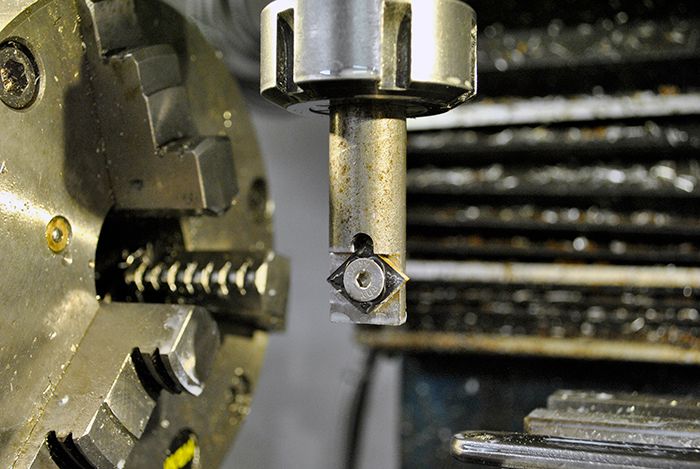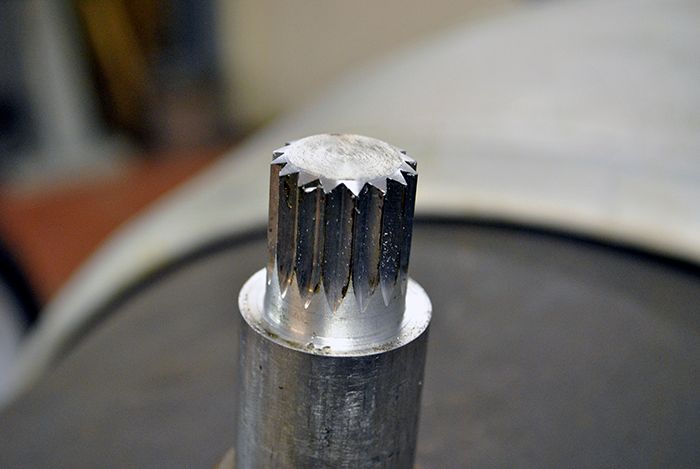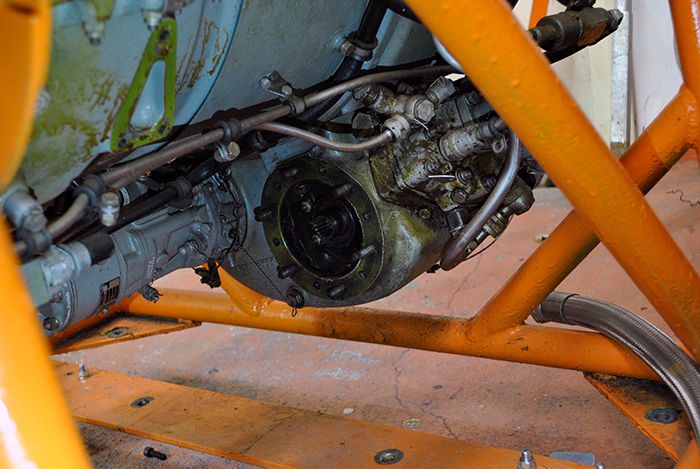|
|
Post by racket on Sept 18, 2014 4:07:57 GMT -5
Hi Anders
That 1500 rpm idle seems very low ..........whats its maximum rpm ??
Cheers
John
|
|
viper
Member
 
Joined: August 2010
Posts: 10
|
Post by viper on Sept 18, 2014 4:09:39 GMT -5
An electric starter would be easier. Find a suitable 24v aircraft starter, reverse the rotation if necessary, make up a flange and spline adapter.
|
|
|
|
Post by Johansson on Sept 18, 2014 5:28:16 GMT -5
Hi Anders That 1500 rpm idle seems very low ..........whats its maximum rpm ?? Cheers John Here are some specs from the Powerjets homepage that Erik linked to: Manufacturer....................................Rolls-Royce (manufactured during the Bristol / R-R takeover) Date of manufacture.........................1966 Series................................................Viper 522 Serial Number..................................522113 Weight..............................................370 kg / 816 lb Centre of Gravity..............................66mm / 2.6" forward of trunnion housing. Type..................................................Turbojet, straight flow, non-reheated. Compressor.......................................8 Stage Axial Turbine.............................................Single Stage Impulse/Reaction Turbine Combustion......................................Annular Combustion Chamber Fuel Injection....................................6 Starter Atomising type Burners and 12 Primary Main Vapourising type burners. Fuel Flow @ Max RPM......................1,551 kg/hr / 3,420 lb/hr Jet Pipe Temperature (JPT)................645°C for normal running ; 740°C max. governed speed ; 800°C max.(start) Ignition..............................................2 High Energy Spark Ignition Modules, 6J @ 3kV. Thrust................................................14.9 kN / 3,360 lbs Jet Pipe Nozzle Diameter...................350mm / 13.7" Maximum RPM.................................13,760 RPM (100% ; 103% allowed for 5 seconds) Self Sustaining Speed.........................1,513 RPM (11%) Fuel....................................................Jet-A1 / AVTUR / AVGAS / AVTAG or any wide cut Kerosine. Oil System.........................................Front bearing & gearbox = scavenge system. Main & rear bearing =metered loss system. Oil Type.............................................Shell ASTO 500 / Mobil Jet Oil / Texaco SATO 7730 / Castrol 580 Oil Consumption................................Less than 1 pint per hour Oil Capacity.......................................7.4 Litres / 13 Pints Nominal Oil Pressure.........................32 psi / 1.44 bar Nominal Oil Temperature..................60-70°C Cooling...............................................Turbine wheel front & back by 7th Stage air. Nose cone/anti icing by 6th stage air. An electric starter would be easier. Find a suitable 24v aircraft starter, reverse the rotation if necessary, make up a flange and spline adapter. Would I need to disconnect the starter once the engine is running or can I safely assume that any 24V aircraft starter will survive being run up to 8000rpm? The thing with an hydraulic starter is that I can spool the engine up at a moderate pace to self sustain revs and increase fuel until it is running. With a 24V starter I have only a limited time to sort everything out before I overheat the starter. I guess that is exactly what has caused the lack of cheap spare starters on the market...  |
|
viper
Member
 
Joined: August 2010
Posts: 10
|
Post by viper on Sept 18, 2014 5:53:05 GMT -5
Some starters would be ok at high rpm otherwise make a one way clutch into the spline adapter.
You need to run the starter on a soft start resistor for a few seconds then full start.
After about 20 seconds, turn of the starter and start fuel solenoid and the engine is self sustaining.
|
|
gidge348
Senior Member
  
Joined: September 2010
Posts: 426 
|
Post by gidge348 on Sept 18, 2014 7:41:09 GMT -5
Looks like we are both looking at the same problem.
So far as power goes the Nimbus starter is rated at 13lb/ft at 1200 rpm or about 3hp.
My friend that races the Triumph at Lake Gairdner & Bonneville suggested using a modified Chain saw with a 3/4 drive socket bar and splined shaft with a socket on it.
The chain saw has a clutch for a soft start plenty of revs, simple, cheap. Just start the engine, disconnect and put it away.
If I can not get my starter fixed, I think this is what I will do?
Cheers Ian...
|
|
|
|
Post by racket on Sept 18, 2014 16:29:40 GMT -5
Hi Anders
Thanks for the data .............she must be a very "accomodating" engine to have such a low self sustain at just 11% ........heh heh , theres hair dryers that spin faster than that ;-)
It'll certainly limit the necessary starter horsepower , I was thinking an idle speed up closer to 5-6,000 rpm where the air loads would be getting pretty high .
Cheers
John
|
|
|
|
Post by racket on Sept 18, 2014 16:32:20 GMT -5
Hi Ian
3hp ..........LOL, I was using that much to start my "little" 10/98 engine ............it sounds like a decent truck starter motor would do the job .
Cheers
John
|
|
|
|
Post by Johansson on Sept 18, 2014 16:57:19 GMT -5
Some starters would be ok at high rpm otherwise make a one way clutch into the spline adapter. You need to run the starter on a soft start resistor for a few seconds then full start. After about 20 seconds, turn of the starter and start fuel solenoid and the engine is self sustaining. Ok, is there any way of telling what kind of speeds the starter is capable of? Most starters I´ve seen on Ebay has little or no information at all in the description except for a part number or so. Looks like we are both looking at the same problem. So far as power goes the Nimbus starter is rated at 13lb/ft at 1200 rpm or about 3hp. My friend that races the Triumph at Lake Gairdner & Bonneville suggested using a modified Chain saw with a 3/4 drive socket bar and splined shaft with a socket on it. The chain saw has a clutch for a soft start plenty of revs, simple, cheap. Just start the engine, disconnect and put it away. If I can not get my starter fixed, I think this is what I will do? Cheers Ian... Hi Ian, That sounds like an easy thing to try, bugger about the starter failing on you. With a power rating of only 3hp a modified chainsaw should work, it is certainly worth a try at least. I made a test spline on a 22mm aluminum shaft today to see if it would fit the starter coupling, but first I had to make a custom spline cutter.  With that I cut 16 splines 2mm deep.  Here is where the starter for the 301 is placed, under the compressor pointing backwards.  Now for the moment of truth, would the home made splines actually fit? Why yes indeed, a snug fit!   Good to know that I am able to make my own coupling shaft between the upcoming starter and the engine, a friend of mine has access to a spark eroding machine but he has his own evening projects so I don´t want to trouble him with my stuff more than necessary. Cheers! /Anders |
|
viper
Member
 
Joined: August 2010
Posts: 10
|
Post by viper on Sept 18, 2014 17:00:11 GMT -5
Viper starters are normally in the 10 to 15 HP range.
A big truck starter might work.
|
|
|
|
Post by Johansson on Sept 18, 2014 17:13:23 GMT -5
Very useful to know the HP rating, thanks Viper!
|
|
|
|
Post by enginewhisperer on Sept 18, 2014 17:15:06 GMT -5
I have a few big turbine engine starter / generators (9kw as a generator I think), but shipping would be pretty expensive!
|
|
|
|
Post by racket on Sept 18, 2014 19:27:39 GMT -5
Hi Anders
The original starter would have needed to be "Mil Rated" , able to start the engine at minus 65 deg F in minimal time , so probably much bigger than required for our less demanding usage .
The starter on my Solar T62 , which has about the same mass flow as our TV94 based engines , is a great big 24 volt motor weighing ~11 kgs -25 lbs ,according to the manual , with a no load speed of ~4-5,000 rpm and drawing ~50 amps at no load ...............when the starter is tested they apply 300 amps at only ~12 volts and the starter should be producing a stalled 16 ft lbs of torque at the output shaft,..... it looks like an ordinary truck starter motor .
Cheers
John
|
|
|
|
Post by Johansson on Sept 19, 2014 2:00:30 GMT -5
I have a few big turbine engine starter / generators (9kw as a generator I think), but shipping would be pretty expensive! Yeah, the shipping wouldn´t come cheap.  Hi Anders The original starter would have needed to be "Mil Rated" , able to start the engine at minus 65 deg F in minimal time , so probably much bigger than required for our less demanding usage . The starter on my Solar T62 , which has about the same mass flow as our TV94 based engines , is a great big 24 volt motor weighing ~11 kgs -25 lbs ,according to the manual , with a no load speed of ~4-5,000 rpm and drawing ~50 amps at no load ...............when the starter is tested they apply 300 amps at only ~12 volts and the starter should be producing a stalled 16 ft lbs of torque at the output shaft,..... it looks like an ordinary truck starter motor . Cheers John Hi John, That is true, I won´t be running the engine in freezing temps so there is probably a little bit less power needed from my starter. Still I would need to have a bit of safety margin so it can spool up the engine pretty fast. Cheers! /Anders |
|
gidge348
Senior Member
  
Joined: September 2010
Posts: 426 
|
Post by gidge348 on Sept 19, 2014 8:03:10 GMT -5
Hi Anders,
I know the shaft you made is just a test, but if the Viper is like the Nimbus the section around the spline behind the face flange is under oil when the engine is running, so will probably need a housing, bearing and seal etc to keep this separate from the outside world.
Cheers Ian...
|
|
gidge348
Senior Member
  
Joined: September 2010
Posts: 426 
|
Post by gidge348 on Sept 19, 2014 8:20:20 GMT -5
|
|